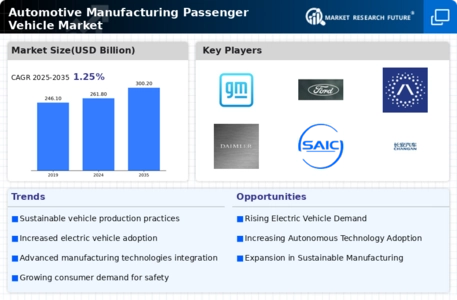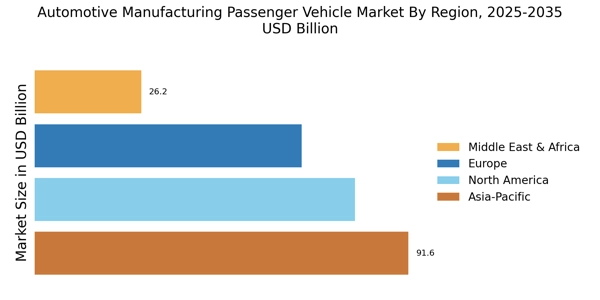Sustainability Initiatives
The Automotive Manufacturing Passenger Vehicle Market is increasingly influenced by sustainability initiatives. Governments and regulatory bodies are implementing stringent emissions standards, compelling manufacturers to innovate and adopt eco-friendly practices. This shift towards sustainability is not merely a trend; it is becoming a fundamental aspect of automotive production. For instance, the demand for electric vehicles (EVs) is projected to rise significantly, with estimates suggesting that EVs could account for over 30% of total vehicle sales by 2030. Consequently, manufacturers are investing heavily in research and development to create more efficient and sustainable vehicles, thereby reshaping the landscape of the Automotive Manufacturing Passenger Vehicle Market.
Growing Demand for Connected Vehicles
The demand for connected vehicles is reshaping the Automotive Manufacturing Passenger Vehicle Market. Consumers are increasingly seeking vehicles that offer connectivity features, such as in-car Wi-Fi, smartphone integration, and advanced infotainment systems. This trend is driven by the desire for enhanced user experiences and the integration of digital technologies into daily life. Market Research Future indicates that the connected vehicle segment is expected to grow substantially, with projections suggesting that the market could reach several billion dollars by 2027. Consequently, manufacturers are prioritizing the development of connected technologies, which is influencing design and production strategies within the Automotive Manufacturing Passenger Vehicle Market.
Shift Towards Shared Mobility Solutions
The shift towards shared mobility solutions is emerging as a significant driver in the Automotive Manufacturing Passenger Vehicle Market. As urbanization increases and consumer preferences evolve, many individuals are opting for car-sharing and ride-hailing services instead of traditional vehicle ownership. This trend is prompting manufacturers to explore new business models and partnerships with mobility service providers. Market data suggests that the shared mobility market could grow exponentially, potentially reaching a valuation of over 300 billion dollars by 2030. This shift is compelling manufacturers to rethink their production strategies and vehicle designs to cater to the changing landscape of transportation within the Automotive Manufacturing Passenger Vehicle Market.
Consumer Preferences for Advanced Safety Features
In the Automotive Manufacturing Passenger Vehicle Market, consumer preferences are shifting towards vehicles equipped with advanced safety features. As awareness of road safety increases, consumers are more inclined to choose vehicles that offer enhanced safety technologies, such as automatic emergency braking, lane-keeping assist, and adaptive cruise control. Market data indicates that vehicles with these features are experiencing higher sales rates, as consumers prioritize safety alongside performance. This trend is prompting manufacturers to integrate these technologies into their designs, thereby influencing production strategies and investment decisions within the Automotive Manufacturing Passenger Vehicle Market.
Technological Advancements in Manufacturing Processes
Technological advancements are playing a pivotal role in the Automotive Manufacturing Passenger Vehicle Market. Innovations such as automation, artificial intelligence, and robotics are streamlining production processes, enhancing efficiency, and reducing costs. For example, the implementation of Industry 4.0 principles is enabling manufacturers to optimize supply chains and improve quality control. As a result, production timelines are shortened, and the ability to respond to market demands is significantly improved. This technological evolution is not only transforming manufacturing practices but also influencing the types of vehicles produced, as manufacturers adapt to new capabilities within the Automotive Manufacturing Passenger Vehicle Market.


















Leave a Comment